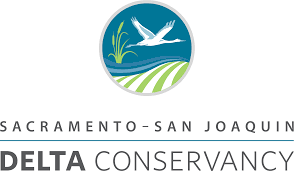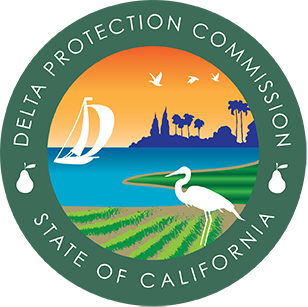State and local agencies
Central Valley Flood Protection Board
Delta Conservancy
 The Delta Reform Act of 2009 established the Sacramento-San Joaquin Delta Conservancy as a primary state agency to implement ecosystem restoration in the Delta and support efforts that advance environmental protection and the economic well-being of Delta residents.
The Delta Reform Act of 2009 established the Sacramento-San Joaquin Delta Conservancy as a primary state agency to implement ecosystem restoration in the Delta and support efforts that advance environmental protection and the economic well-being of Delta residents.
The Conservancy goals include protecting and enhancing habitat restoration, Delta agriculture, and working landscapes; providing increased opportunities for tourism and recreation; working in conjunction with the Delta Protection Commission to promote legacy communities, economic vitality, and flood risk reduction and response; protecting and improving water quality; and protecting, conserving, and restoring the region’s physical, agricultural, cultural, historical, and living resources.
The Conservancy is governed by a 13-member board representing the five Delta counties, local nonprofits, special districts, and state and federal agencies.
The Delta Conservancy collaborates with local communities, interested groups, fellow science experts, and state and federal agencies to seek creative opportunities to address challenges and progress these efforts within the Delta.
Some of the Conservancy’s many programs include the Arundo Control and Restoration Project, the Delta Interagency Invasive Species Coordination Team, and Delta branding and marketing. In addition, the Conservancy has been very active in carbon sequestration studies and pilot projects within the Delta. The Conservancy also collaborates with other agencies on implementing the Delta Mercury Exposure Reduction Program, partnering on Delta waterway cleanups, and other programs.
The Conservancy runs several grant programs disbursing funds from Prop 1, Prop 68, and the Delta Drought Response Program.
Click here for coverage of the Delta Conservancy on Maven’s Notebook.
Delta Protection Commission
 The Delta Protection Commission is the oldest of the three Delta agencies, established by the Delta Protection Act of 1992 and most recently amended by the 2009 Delta Reform Act. The mission of the Delta Protection Commission is to protect, maintain, and, where possible, enhance and restore the overall quality of the Delta environment consistent with the Delta Protection Act. The goal of the Commission is to ensure orderly, balanced conservation and development of Delta land resources and improved flood protection.
The Delta Protection Commission is the oldest of the three Delta agencies, established by the Delta Protection Act of 1992 and most recently amended by the 2009 Delta Reform Act. The mission of the Delta Protection Commission is to protect, maintain, and, where possible, enhance and restore the overall quality of the Delta environment consistent with the Delta Protection Act. The goal of the Commission is to ensure orderly, balanced conservation and development of Delta land resources and improved flood protection.
The Delta Protection Commission is charged with adopting, maintaining, and implementing the Land Use and Resource Management Plan, which guides projects impacting land use, agriculture, natural resources, recreation and accessibility, water, levees, and utilities and infrastructure in the primary zone of the Delta. General plans and projects in the five Delta counties must be consistent with the LURMP.
The Delta Protection Commission also prepared the Economic Sustainability Plan for the Delta and recently updated the chapters on agriculture, recreation, and tourism. The Commission has developed a plan to increase broadband access in the Delta. The Commission also is working on developing the Great California Delta Trail and creation of the Delta National Heritage Area.
The Commission has fifteen members, largely from the Delta region, to provide for stakeholder representation in agriculture, habitat, and recreation. The members include:
- One member of the Board of Supervisors of each of the five counties within the Delta (Contra Costa, Sacramento, San Joaquin, Solano, and Yolo), whose supervisorial district is within the Primary Zone;
- An elected city council member representing the County of San Joaquin;
- An elected city council member representing the Counties of Contra Costa and Solano (on a rotating basis);
- An elected city council member from the regional and area councils of government representing the Counties of Sacramento and Yolo;
- Landowners from north, south, and central Delta reclamation districts;
- High-level leaders from Business, Transportation, and Housing, the Natural Resources Agency, Food, and Agriculture, and the State Lands Commission; and
- Two ex-officio members that are representatives of the Senate and Assembly.
The Delta Protection Commission is advised by the Delta Protection Advisory Committee (DPAC). They provide recommendations to the Commission on diverse interests within the Delta, including the Delta’s ecosystem, water supply, socioeconomic sustainability, recreation, agriculture, flood control, environment, water resources, utility infrastructure, and other Delta issues.
Click here for coverage of the Delta Protection Commission on Maven’s Notebook.
Delta Stewardship Council
 In November 2009, the California Legislature passed SBX7 1, otherwise known as the Delta Reform Act, establishing the Delta Stewardship Council, among other things. The Council is comprised of seven members from various backgrounds and from different parts of the state that provide a statewide perspective and diverse expertise. Of the seven members, four are appointed by the Governor, one each by the Senate and Assembly, and the seventh member is the Chair of the Delta Protection Commission. The current Council members are listed here.
In November 2009, the California Legislature passed SBX7 1, otherwise known as the Delta Reform Act, establishing the Delta Stewardship Council, among other things. The Council is comprised of seven members from various backgrounds and from different parts of the state that provide a statewide perspective and diverse expertise. Of the seven members, four are appointed by the Governor, one each by the Senate and Assembly, and the seventh member is the Chair of the Delta Protection Commission. The current Council members are listed here.
The Delta Reform Act charged the newly-formed Council with developing the Delta Plan, an enforceable long-term plan to manage the Delta’s resources to achieve the ‘coequal goals,’ which the legislation defines as a more reliable statewide water supply and a healthy and protected ecosystem, both achieved in a manner that protects and enhances the unique characteristics of the Delta as an evolving place.
The first Delta Plan was adopted in 2013 and has chapters on water supply reliability, ecosystem restoration, protection of Delta as an evolving place, water quality, and flood risk reduction. The Delta Plan includes regulatory policies that agencies and projects must comply with as well as non-binding recommendations. And while some of the Delta Plan’s regulations do apply to habitat restoration projects and development within floodplains, the Delta Stewardship Council does not have any land use authority. Click here for a list of all the Delta Plan’s regulations.
The Delta Reform Act requires any state or local agency proposing to undertake a covered action must submit to the Council a written certification of consistency with the Delta Plan. The legislation defines a covered action as a plan, program, or project that a state or local agency proposes to do within the Delta and Suisun Marsh that is covered by one or more policies of the Delta Plan. Any person, be it a Council member, another agency, or a member of the public, who believes a covered action is inconsistent with the Delta Plan may appeal the certification of consistency to the Council within 30 days of the submission date. It is important to note that the scope of the appeal is limited to only the consistency of the plan or project with the Delta Plan’s regulatory policies.
Click here for coverage of the Delta Stewardship Council on Maven’s Notebook.
Delta Independent Science Board
The Delta Reform Act also established the Delta Independent Science Board (or DISB), which replaced the previous CalFed science board. The DISB is a ten-member board comprised of prominent scientists from across the nation who have appropriate expertise to evaluate the broad range of scientific programs that support adaptive management of the Delta. The DISB provides oversight through periodic reviews of research, monitoring and assessment programs in the Delta. Since its inception, the DISB has produced reports on restoration, adaptive management, water quality, invasive species, and other important topics. They have also reviewed and provided input on important documents that inform decision-making, such as the Council’s Delta Plan amendments and environmental review documents for Delta conveyance.
Click here for coverage of the Delta Independent Science Board on Maven’s Notebook.
Delta Lead Scientist
The Council also includes the Delta Science Program, which provides the best possible unbiased scientific information to inform water and environmental management decisions for the Delta. The Council appoints a Delta Lead Scientist to oversee the program.
Click here for coverage of the Delta Lead Scientist on Maven’s Notebook.
Delta Plan Interagency Implementation Committee (DPIIC)
To ensure coordinated action at the federal, state, and local levels, the Council convenes the Delta Plan Interagency Implementation Committee (or DPIIC), which brings together the heads of state, federal, and local agencies to collaborate on Delta Plan implementation through the support of shared national, statewide and local goals for the Delta. DPIIC meets at least twice yearly.
Click here for coverage of the DPIIC on Maven’s Notebook.
State Water Resources Control Board
Federal agencies
Army Corps of Engineers
Bureau of Reclamation

